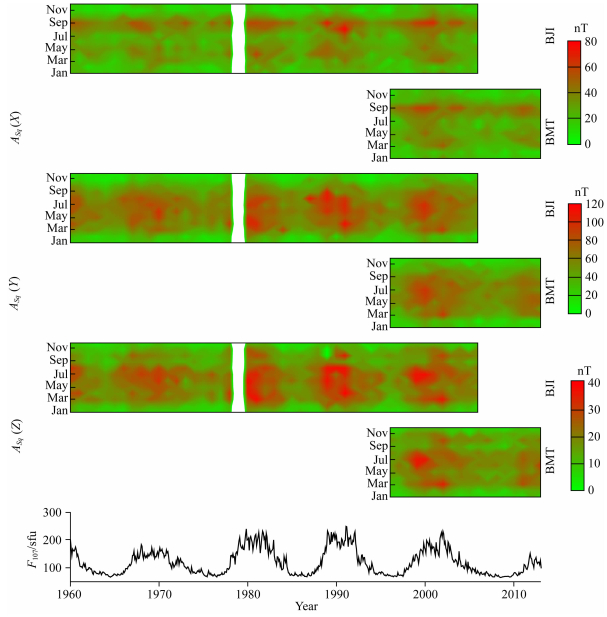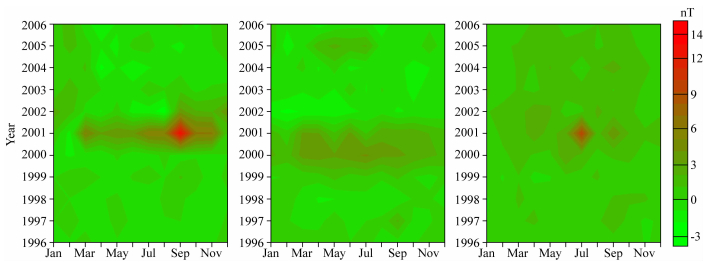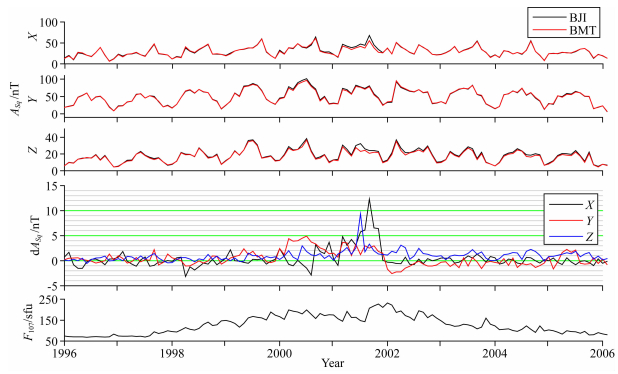随着全世界对全球变化研究热潮的开始,从20世纪90年代起,中高层大气领域关于长期变化的研究也成为了科学家非常关注的一个重点问题(Aikin et al., 1991; Roble, 1995; Ulich and Turunen, 1997; Jarvis et al., 1998; Laštovička, 2005, 2009).研究发现,电离层的长期变化现象与来自太阳和地球内部的诸多因素之间存在密切关系.例如温室气体浓度升高(Roble et al., 1989; Rishbeth, 1990; Hall and Cannon, 2002)、太阳活动的长期变化(Torta et al., 2009)、地磁活动的长期变化(Danilov and Mikhailov, 1999; Mikhailov and Marin, 2000),以及地球磁场的长期变化等(Foppiano et al., 1999; Elias and De Adler, 2006; Cnossen and Richmond, 2008; Yue et al., 2008; Elias, 2009).
太阳静日变化Sq,是地磁活动平静期间在中低纬度地区的地磁场记录中观测到的一种稳定的周日变化(Chapman and Bartels, 1940).它主要起源于位于电离层E区的发电机电流体系,热层风和磁层电磁过程也有一定的贡献(Matsushita, 1967; Tarpley, 1970; Hasegawa, 1960; Matsushita and Xu, 1982; Richmond, 1989).电离层发电机电流系由日侧电离层约110 km高度处,位于南北半球的两个电流涡组成.其中北半球电流涡为反时针方向,而南半球电流涡呈顺时针方向(Campbell, 1989, 1997).
由于受到电离层电导率、发电机电场、太阳周日潮和E区电离层密度等因素的共同作用,Sq场具有显著的逐日变化(Stening et al., 2005, 2007; Chen et al., 2007; Kirchhoff and Carpenter, 1976; Torta et al., 1997).来自地球深部地核产生的地球主磁场,其强度和方向存在明显的长期变化.根据电离层发电机与地球磁场之间的因果关系容易推论,地球磁场的各种变化都会对Sq产生直接影响.例如地磁场方向特别是磁赤道位置的漂移,可能对整个Sq系统产生极大的影响(Cnossen and Richmond, 2013).另外,温室气体浓度的增加,对E层电子密度峰值也可能产生作用,从而导致Sq场产生变化(Rishbeth and Roble, 1992; Bremer, 2004, 2008; Briggs, 1984).在这些因素的共同作用下,除逐日变化外,Sq还表现出多种时间尺度的周期扰动,包括季节变化、27天变化和11年太阳活动周等特征(Briggs, 1984; 吴迎燕等,2012;Aikin et al., 1991).
虽然早在半个世纪前科学家就已经针对Sq场与太阳活动之间的密切关系问题进行了大量的研究和总结(Rishbeth,1990),但是这一问题并未得到完全认识,至今仍然是科学家关注的重点问题(Sellek,1980;Schlapp et al., 1990; Elias et al., 2010; Takeda, 2013).本文的目的在于,利用北京地区过去几十年积累的地磁场观测资料,研究该地区地磁场Sq强度的季节变化和长期变化,讨论与太阳活动之间的密切关系.
1 使用的数据和方法北京地区的地磁场观测,先后由北京白家疃地磁台(BJI)和北京十三陵地磁台进行.其中,北京白家疃地磁台即北京台,是我国开始基准地磁观测的“老八台”之一.该台站由中国科学院地球物理研究所于1952年选址、兴建,1957年正式投入观测,是我国解放后设计建立的第一座永久性地磁台.1978年中国科学院地球所分所后,该台站划归中国地震局地球物理研究所管理.北京台的选址建设均按照国际建台规范,远离地磁观测区,采用弱磁性材料.20世纪80年代中期以前台站周围几乎没有其他建筑,观测条件非常优越.但到20世纪80年代中期以后,到90年代初台站周围陆续修建民居和工厂,对地磁场观测骚扰很大.目前,台站处于各种用途的建筑物包围之中,对地磁观测影响较大,近年来已经很难保证获得可靠的观测资料(刘长发,1998;王晓祜等,2007).
北京十三陵地磁台(BMT)位于昌平县德胜口村,距市中心50多公里,周围为国有山林地,其地质基底为石英岩和灰质岩.该台站由中国科学院地球物理研究所于1978—1985年期间勘选台址,1986年开始建设,至1991年正式观测,是我国最早实现数字化的地磁台.由于该台站位于十三陵风景区,周边建筑较少,始终能保证良好的磁测环境.其数据可靠性较高,是我国率先加入国际地磁台网INTERMAGNET的地磁台站,向全球科学家共享地磁场观测数据(刘长发,1998).
本文使用的数据包括北京台从1960—2006年、北京十三陵台从1996年至2013年的地磁场X、Y和Z分量的时均值数据(具体见表 1).虽然这两个台站相距大约30 km,但是考虑本文所要讨论的季节变化和长期变化为较长周期变化问题,并且Sq场源为大尺度电离层电流的特点,因此认为此二台站空间位置差距的影响可以忽略.将两个台站数据联合利用,以弥补单个台站观测间断的缺憾.为了考察与太阳活动之间的关系,选用太阳活动F107指数进行对比分析.太阳F107指数是指太阳10.7 cm波长(2800 MHz)的射电辐射通量,是表征太阳活动水平的一个重要参量.其单位为太阳通量单位(SFU),取值的范围在60~300之间.
|
|
表 1 使用的台站及数据范围 Table 1 Observatories and data time range |
每月地磁场Sq的计算,采用长期以来所普遍使用的方法.首先对数据进行预处理,利用子夜数据均值(地方时23点到01点)剔除背景场的贡献.然后根据每月五天国际磁静日数据求取平均值,得到每月平均Sq(X)、Sq(Y)和Sq(Z).Sq的强度由每月Sq的白天数值求其极大值与极小值之差得到,并记做ASq(X)、ASq(Y)和ASq(Z)(Takeda, 2002, 2003).
2 分析结果 2.1 北京地区地磁场Sq变化图 1给出1960—2013年期间F107指数,以及BJI台和BMT台Sq(X)、Sq(Y)和Sq(Z).图中BJI台1979年前后的白色区块表示1979年该台站因缺失数据而造成插值空白(后文图 2中与此处相同,不再复述).从所有年份Sq(X)、Sq(Y)和Sq(Z)的地方时分布看,两个台站Sq的幅度值范围非常相近,并且具有相似而稳定的地方时变化.其中,Sq(X)在中午附近急剧减小并达到极小值,同时呈现午后增强;而Sq(Y)则发生午前增强,且在中午附近急剧减小并达到极小值;Sq(Z)在中午附近急剧减小,但没有发生午后增强现象.与太阳活动F107指数对比,Sq(X)、Sq(Y)和Sq(Z)与F107指数存在明显的正相关关系.当F107增强时,正午附近Sq场的强度也同时增强.反之情况类似,当F107指数逐渐减小,Sq强度也同时减小.

|
图 1 1960—2013年BJI和BMT地磁台Sq(X)、Sq(Y)和Sq(Z),及F107指数变化 Fig. 1 Variations of Sq(X), Sq(Y), Sq(Z) in BJI and BMT observatories and F107 index from 1960 to 2013 |

|
图 2 1960—2013年BJI和BMT地磁台ASq(X)、ASq(Y)和ASq(Z),及F107指数变化 Fig. 2 Variations of ASq(X), ASq(Y), ASq(Z) in BJI and BMT observatories and F107 index from 1960 to 2013 |
根据所有年份每月平均Sq计算其周日极差值表示Sq强度,记做ASq(X)、ASq(Y)和ASq(Z),结果如图 2所示.显而易见,Sq(X)、Sq(Y)和Sq(Z)的强度明显受到太阳活动的影响,其时间变化与F107指数息息相关.当F107增强和减小时,ASq(X)、ASq(Y)和ASq(Z)也发生同步增强和减小.在太阳活动高年和低年,Sq强度也随之达到了峰值和谷值.在太阳活动性较弱的第20个太阳活动周1970年前后,ASq(X)、ASq(Y)和ASq(Z)明显要低于随后的三个太阳活动周高年的强度.而在太阳活动高年1990年前后,F107指数呈现双峰结构,与之对应,ASq(X)、ASq(Y)和ASq(Z)也表现出双峰结构.这些结果与早期地磁学家Chapman和Bartels在1940年研究总结的Sq场与太阳活动的密切依赖关系完全一致.
此外,从图中还可以看出,ASq(X)具有明显的季节变化.即在春秋季月份,ASq(X)发生显著增强,并且在秋季达到一年之中强度极大值.而ASq(Y)则主要表现出年变化特征,在夏季月份强度达到最大.
进一步考察Sq强度逐月变化的统计特征.将1960至2013年期间所有年份ASq做平均计算,结果记作ASq.如图 3所示,其中虚、实线分别表示BJI和BMT地磁台ASq(X)、ASq(Y)和ASq(Z).可以看到,BJI和BMT两个台站三个磁场分量的Sq强度的逐月变化几乎完全一致.其中,ASq(X)呈现春秋增强而冬夏减弱的季节变化,其强度在秋季达到最大值,在冬季达到最小值.而ASq(Y)具有夏季增强冬季减弱的半年变化.ASq(Z)变化略为复杂,其强度在5月和9月出现减小,但从总体变化来看具有夏季增强冬季减弱的半年变化特征.从Sq强度大小来看,BJI和BMT两个台站Sq的强度相差不大,两台站之间的差值最大仅为几个nT.

|
图 3 BJI和BMT地磁台ASq(X)、ASq(Y)和ASq(Z)变化 Fig. 3 Variations of ASq(X), ASq(Y) and ASq(Z) in BJI and BMT observatories |
下面将所有年份每月ASq(X)、ASq(Y)和ASq(Z)做年滑动平均和11年滑动平均计算,考察北京地区Sq强度的长期变化,结果见图 4.显而易见,X、Y、Z三个磁场分量ASq均具有明显的11年太阳活动周变化特征,与F107指数存在显著的正相关关系.从长期变化来看,1960—2010年期间F107指数经历了一个从逐渐增强而后缓慢减弱的过程,在1988年附近达到太阳活动峰值.同样,ASq(X)、ASq(Y)和ASq(Z)也呈现出一致的太阳活动的长期变化.三个地磁场分量中,以ASq(Y)长期变化的变化幅度较为突出.ASq曲线的11年变化和长期变化,反映出了Sq对太阳活动的密切依赖关系.

|
图 4 1960—2006年BJI台ASq和F107指数的年滑动平均值和11年滑动平均值的变化 Fig. 4 Annual average and 11 years moving average of the ASq in BJI and F107 index from 1960 to 2006 |
从台站记录来看,1996至2006年BJI和BMT两个台站具有同期观测数据,下面根据该时期的观测资料对两个台站Sq强度变化的异同特征进行分析,进一步深入对地磁场Sq在局部空间结构的认识.将图 2中1996—2006年两个台站地磁场X、Y、Z三个分量ASq分别相减,得到差值dASq(即等于ASqBJI-ASqBMT),结果如图 5所示.可以看出,除2001年以外的其他年份,dASq的幅值都很小,一般不超过±2 nT,说明两个台站观测到的Sq强度差异不大.然而2001年dASq表现较为异常,其幅值明显要高于其他年份.

|
图 5 1996—2006年dASq的变化 Fig. 5 Variations of dASq from 1996 to 2006 |
将太阳活动F107指数与BJI台和BMT台得到的ASq和dASq进行对比,如图 6所示.很明显,所有年份中两个台站ASq(X/Y/Z)的变化曲线的趋势和强度几乎完全一致.并且在三个地磁场分量的变化曲线中,存在明显的季节变化和半年变化.在大多数年份,两个台站Sq的强度差值dASq主要分布在[-2, 2]nT范围,没有发现明显的季节或年周期性变化特征.特别突出的是,2000年和2001年dASq发生显著增强.这两年内dASq的平均幅度达到4.3、2.2和2.3 nT(X/Y/Z),远远高于其他年份.在2001年9月dASq(X)甚至达到了12.3 nT的最大值.

|
图 6 1996—2006年BJI和BMT台ASq、dASq和F107指数的变化 Fig. 6 Variations of ASq, dASq in BJI and BMT, and F107 index during 1996 and 2006 |
根据太阳活动F107指数可知,1996至2006年属于第23个太阳活动周,其中2000和2001年处于第23周太阳活动高年.从X、Y和Z三个地磁场分量ASq的变化曲线可以看出,随着F107指数增强,ASq也随之增强.其相应的11年太阳活动周变化可以从图 4中ASq的年滑动平均曲线更为清晰可见.类似地,在2000年和2001年太阳活动高年,dASq也出现了显著增强.反映出北京地区Sq场强度梯度的剧烈扰动与太阳活动之间存在着密切的关系.同时也意味着在太阳活动高年,Sq电离层发电机电流的局部结构可能发生了明显的变化.这一推断需要未来进一步收集更多的资料来加以证实.
3 结论本文利用北京台和北京十三陵地磁台的地磁场数据,分析研究了北京地区地磁场Sq强度的季节变化和长期变化,并讨论与太阳活动之间的关系.得到主要结论如下:
(1) 所有年份数据显示,BJI和BMT两个台站地磁场Sq不仅强度范围相近,并且具有相似的稳定的地方时变化、季节变化、太阳活动周变化和长期变化.
(2) BJI台和BMT台Sq强度的逐月变化,其中ASq(X)主要表现为春秋增强而冬夏减弱的季节变化.ASq(Y)呈现出夏季增强的半年变化.ASq(Z)变化较为复杂.虽然在5月和9月出现减小,但是总体来看,其变化曲线也具有夏季增强的半年变化特征.Sq强度与太阳活动F107指数之间存在正相关关系,具有一致的11年太阳活动周变化和长期变化,反映出了Sq与太阳活动之间的密切关系.
(3) 从BJI和BMT两个台站Sq强度计算得到的差值dASq的变化曲线看出,在大多数年份,两个台站Sq强度差值dASq一般不超过±2 nT,没有明显的季节或年周期变化特征.在2000年和2001年太阳活动高年,dASq出现显著增强,最大可达12.3 nT.反映出了北京地区Sq场强度梯度的剧烈扰动与太阳活动之间的密切关系,暗示了在太阳活动高年,Sq电离层发电机电流的局部结构可能发生了明显的变化.
Aikin A C, Chanin M L, Nash J, et al. 1991. Temperature trends in the lower mesosphere. Geophysical Research Letters, 18(3): 416-419. DOI:10.1029/91GL00233 |
Bremer J. 2004. Investigations of long-term trends in the ionosphere with world-wide ionosonde observations. Advances in Radio Science, 2: 253-258. |
Bremer J. 2008. Long-term trends in the ionospheric E and F1 regions. Annales Geophysicae, 26(5): 1189-1197. DOI:10.5194/angeo-26-1189-2008 |
Briggs B H. 1984. The variability of ionospheric dynamo currents. Journal of Atmospheric and Terrestrial Physics, 46(5): 419-429. DOI:10.1016/0021-9169(84)90086-2 |
Campbell W H. 1989. The regular geomagnetic-field variations during quiet solar conditions. //Jacobs J A ed. Geomagnetism. New York: Elsevier, 3: 385-460.
|
Campbell W H. 1997. Introduction to Geomagnetic Fields. New York: Cambridge UniversityPress.
|
Chapman S, Bartels J. 1940. Geomagnetism. London: Oxford University Press.
|
Chen G X, Xu W Y, Du A M, et al. 2007. Statistical characteristics of the day-to-day variability in the geomagnetic Sq field. Journal of Geophysical Research:Space Physics, 112(A6): A06320. DOI:10.1029/2006JA012059 |
Cnossen I, Richmond A D. 2008. Modelling the effects of changes inthe Earth's magnetic field from 1957 to 1997 on the ionospheric hmF2 and foF2 parameters. Journal of Atmospheric and Solar-Terrestrial Physics, 70(11-12): 1512-1524. DOI:10.1016/j.jastp.2008.05.003 |
Cnossen I, Richmond A D. 2013. Changes in the Earth's magneticfield over the past century:Effects on the ionosphere-thermosphere systemand solar quiet (Sq) magnetic variation. Journal of Geophysical Research:Space Physics, 118(2): 849-858. DOI:10.1029/2012JA018447 |
Danilov A D, Mikhailov A V. 1999. Long-term trends in the parametersof the F2 region:A new approach. Geomagnetism and Aeronomy, 39(4): 473-479. |
Elias A G, De Adler N O. 2006. Earth magnetic field and geomagnetic activity effects on long-term trends in the F2 layer at mid-high latitudes. Journal of Atmospheric and Solar-Terrestrial Physics, 68(17): 1871-1878. DOI:10.1016/j.jastp.2006.02.008 |
Elias A G. 2009. Trends in the F2 ionospheric layer due to long-term variationsin the Earth's magnetic field. Journal of Atmospheric and Solar-Terrestrial Physics, 71(14-15): 1602-1609. DOI:10.1016/j.jastp.2009.05.014 |
Elias A G, De Artigas M Z, De Haro Barbas B F. 2010. Trends in the solar quiet geomagnetic field variation linked to the Earth's magneticfield secular variation and increasing concentrations of greenhouse gases. Journal of Geophysical Research, 115(A8): A08316. DOI:10.1029/2009JA015136 |
Foppiano A J, Cid L, Jara V. 1999. Ionospheric long-term trends for South American mid-latitudes. Journal of Atmospheric and Solar-Terrestrial Physics, 61(9): 717-723. DOI:10.1016/S1364-6826(99)00025-5 |
Hall C M, Cannon P S. 2002. Trends in foF2 above Tromsø (69°N 19°E). Geophysical Research Letters, 29(23): 2128. DOI:10.1029/2002GL016259 |
Hasegawa M. 1960. On the position of the focus of the geomagnetic Sq current system. Journal of Geophysical Research, 65(5): 1437-1447. DOI:10.1029/JZ065i005p01437 |
Jarvis M J, Jenkins B, Rodgers G A. 1998. Southern hemisphere observations of a long-term decrease in F region altitude and thermospheric wind providing possible evidence for global thermospheric cooling. Journal of Geophysical Research, 103(A9): 20774-20788. |
Kirchhoff V W J H, Carpenter L A. 1976. The day-to-day variabilityin ionospheric electricfields and currents. Journal of Geophysical Research, 81(16): 2737-2742. DOI:10.1029/JA081i016p02737 |
Laštovička J. 2005. On the role of solar and geomagnetic activity in long-termtrends in the atmosphere-ionosphere system. Journal of Atmospheric and Solar-Terrestrial Physics, 67(1-2): 83-92. DOI:10.1016/j.jastp.2004.07.019 |
Laštovička J. 2009. Global pattern of trends in the upper atmosphere and ionosphere:Recent progress. Journal of Atmospheric and Solar-Terrestrial Physics, 71(14-15): 1514-1528. DOI:10.1016/j.jastp.2009.01.010 |
Liu C F. 1998. The constructions and observations of China (East Asia) meridian chain of geomagnetometers and "INTERMAGNET". Progress in Geophysics (in Chinese), 13(3): 83-98. |
Matsushita S. 1967. Solar quiet and lunar daily variation fields. //Matsushit S, Campbell W eds. Physics of Geomagnetic Phenomena. New York: Elsevier, 301-424.
|
Matsushita S, Xu W Y. 1982. Equivalent ionospheric current systems representing solar daily variations of the polar geomagnetic field. Journal of Geophysical Research:Space Physics, 87(A10): 8241-8254. DOI:10.1029/JA087iA10p08241 |
Mikhailov A V, Marin D. 2000. Geomagnetic control of the foF2 long-term trends. Annales Geophysicae, 18(6): 653-665. DOI:10.1007/s00585-000-0653-2 |
Richmond A D. 1989. Modeling the ionosphere wind dynamo:A review. Pure and Applied Geophysics, 131(3): 413-435. DOI:10.1007/BF00876837 |
Rishbeth H. 1990. A greenhouse effect in the ionosphere?. Planetary and Space Science, 38(7): 945-948. DOI:10.1016/0032-0633(90)90061-T |
Rishbeth H, Roble R G. 1992. Cooling of the upper atmosphere by enhanced greenhouse gases-Modeling of thermospheric and ionospheric effects. Planetary and Space Science, 40(7): 1011-1026. DOI:10.1016/0032-0633(92)90141-A |
Roble R G, Dickinson R E. 1989. How will changes in carbon dioxide and methane modify the mean structure of the mesosphere and thermosphere?. Geophysical Research Letters, 16(12): 1441-1444. DOI:10.1029/GL016i012p01441 |
Roble R G. 1995. Major greenhouse cooling (yes, cooling):The upper atmosphere response to increased CO2. Reviews of Geophysics, 33(S1): 539-546. |
Schlapp D M, Sellek R, Butcher E C. 1990. Studies of world wide secular trends in the solar daily geomagnetic variation. Geophysical Journal International, 100(3): 469-475. DOI:10.1111/gji.1990.100.issue-3 |
Sellek R. 1980. Secular trends in daily geomagnetic variations. Journal of Atmospheric and Terrestrial Physics, 42(8): 689-695. DOI:10.1016/0021-9169(80)90052-5 |
Stening R, Reztsova T, Minh L H. 2005. Day-to-day changes in the latitudes of the foci of the Sq current system and their relation to equatorial electrojet strength. Journal of Geophysical Research:Space Physics, 110(A10): A10308. DOI:10.1029/2005JA011219 |
Stening R, Reztsova T, Minh L H. 2007. Variation of Sq focus latitudes in the Australian/Pacific region during a quiet sun year. Journal of Atmospheric and Solar-Terrestrial Physics, 69(6): 734-740. DOI:10.1016/j.jastp.2006.12.002 |
Takeda M. 2002. Features of global geomagnetic Sq field from 1980 to 1990. Journal of Geophysical Research:Space Physics, 107(A9): 1252. DOI:10.1029/2001JA009210 |
Takeda M, Iyemori T, Saito A. 2003. Relationship between electric field and currents in the ionosphere and the geomagnetic Sq field. Journal of Geophysical Research:Space Physics, 108(A5): 1183. DOI:10.1029/2002JA009659 |
Takeda M. 2013. Difference in seasonal and long-term variations in geomagnetic Sq fields between geomagnetic Y and Z components. Journal of Geophysical Research:Space Physics, 118(5): 2522-2526. DOI:10.1002/jgra.50128 |
Tarpley J D. 1970. The ionospheric wind dynamo-Ⅱ. solar tides. Planetary and Space Science, 18(7): 1091-1103. DOI:10.1016/0032-0633(70)90110-8 |
Torta J M, Curto J J, Bencze P. 1997. Behavior of the quiet day ionospheric current system in the European region. Journal of Geophysical Research:Space Physics, 102(A2): 2483-2494. DOI:10.1029/96JA03463 |
Torta J M, Gaya-Piqué L R, Curto J J, et al. 2009. An inspection of the long-term behaviour of the range of the daily geomagnetic field variation from comprehensive modelling. Journal of Atmospheric and Solar-Terrestrial Physics, 71(13): 1497-1510. DOI:10.1016/j.jastp.2008.06.006 |
Ulich T, Turunen E. 1997. Evidence for long-term cooling of the upper atmosphere in ionosonde data. Geophysical Research Letters, 24(9): 1103-1106. DOI:10.1029/97GL50896 |
Wang X H, Lv Z, Zhou J L, et al. 2007. The geomagnetic gradients monitoring of the Beijing Geomagnetic Observatory. Seismological and Geomagnetic Observation and Research (in Chinese), 28(3): 52-61. |
Wu Y Y, Xu W Y, Chen G X. 2012. Analysis of the periodical characteristics of Sq index. Chinese Journal of Geophysics (in Chinese), 55(3): 953-959. DOI:10.6038/j.issn.0001-5733.2012.03.025 |
Yue X N, Liu L B, Wan W X, et al. 2008. Modeling the effects of secular variation of geomagnetic field orientation on the ionospheric longterm trend over the past century. Journal of Geophysical Research:Space Physics, 113(A10): A10301. DOI:10.1029/2007JA012995 |
刘长发. 1998. 中国(东亚)地磁台链建设及其观测与国际地磁卫星台网. 地球物理学进展, 13(3): 83-98. |
王晓祜, 吕智, 周江林, 等. 2007. 北京地磁台的磁环境监测. 地震地磁观测与研究, 28(3): 52-61. DOI:10.3969/j.issn.1003-3246.2007.03.011 |
吴迎燕, 徐文耀, 陈耿雄. 2012. Sq指数的周期变化分析. 地球物理学报, 55(3): 953-959. DOI:10.6038/j.issn.0001-5733.2012.03.025 |
 2018, Vol. 61
2018, Vol. 61

